Model Test Study on the Enhancement of Ecological Self-Repairing Ability of Surface Slope Soil by New Polymer Composites
Abstract
:1. Introduction
2. Climatic Conditions in the Study Area
3. Test Materials and Methods
3.1. Materials
3.2. Test Method
3.2.1. Compactness of Soil
3.2.2. Biochemical Properties of Soil
3.2.3. Plant Growth
4. Result
4.1. Variation Trend of Soil Compactness
4.2. Organic Matter Content
4.3. Total and Available Nutrient Content of the Soil
4.4. Microorganism Content of the Soil
4.5. Plant Growth Effect
4.5.1. Germination Rate, Germination Time, and Growth Curve
4.5.2. Plant Coverage Rate
5. Discussion
5.1. Effect of ADNB on Compactness
5.2. Effect of ADNB on Organic Matter
5.3. Effect of ADNB on Soil Nutrients and Microorganisms
5.4. Effect of ADNB on Plant Growth
5.5. Effect of Material Ratio on Improvement Effect
6. Mechanistic Analysis
6.1. Soil Improvement Mechanism
6.2. The Long-Term Effect
7. Conclusions
- (1)
- A new polymer composite material (ADNB) was compounded with a polymer nano-aqueous binder (NAB) and super absorption resin (SAR) for improving the surface soil of slopes. The results show that ADNB can not only improve the stability of slopes by increasing the compactness of soil, but also optimize the water and fertilizer supply capacity of soil by increasing the amount of organic matter, available nutrients, and microorganisms in soil.
- (2)
- Outdoor model tests were conducted based on the new polymer composite material (ANDB), and it was found that ADNB can enhance the ecological self-repairing ability of surface slope soil by improving soil structure, reducing soil erosion, and optimizing water and fertilizer supply, thus promoting plant growth; the degradation period is as long as 24–36 months, which can completely cover two to three growth periods of plants and can provide sufficient growth time for the growth and natural evolution of vegetation communities.
- (3)
- ADNB needs to select an optimal proportioning scheme according to the actual situation, taking into account the local soil quality, climate, rainfall, etc., so as to meet the stability requirements while controlling the looseness of the soil in an appropriate range to achieve the optimal improvement effect.
Author Contributions
Funding
Institutional Review Board Statement
Informed Consent Statement
Data Availability Statement
Acknowledgments
Conflicts of Interest
References
- Au, S.W.C. Rain-Induced Slope Instability in Hong Kong. Eng. Geol. 1998, 51, 1–36. [Google Scholar] [CrossRef]
- Zhang, X.; Song, J.; Wang, Y.; Sun, H.; Li, Q. Threshold Effects of Vegetation Coverage on Runoff and Soil Loss in the Loess Plateau of China: A Meta-Analysis. Geoderma 2022, 412, 115720. [Google Scholar] [CrossRef]
- Lomba, A.; Ferreiro da Costa, J.; Ramil-Rego, P.; Corbelle-Rico, E. Assessing the Link between Farming Systems and Biodiversity in Agricultural Landscapes: Insights from Galicia (Spain). J. Environ. Manag. 2022, 317, 115335. [Google Scholar] [CrossRef] [PubMed]
- Xu, Y.; Li, H.; Tan, L.; Li, Q.; Liu, W.; Zhang, C.; Gao, Y.; Wei, X.; Gong, Q.; Zheng, X. What Role Does Organic Fertilizer Actually Play in the Fate of Antibiotic Resistome and Pathogenic Bacteria in Planting Soil? J. Environ. Manag. 2022, 317, 115382. [Google Scholar] [CrossRef]
- Sun, L.; Zhang, B.; Yin, Z.; Guo, H.; Siddique, K.H.M.; Wu, S.; Yang, J. Assessing the Performance of Conservation Measures for Controlling Slope Runoff and Erosion Using Field Scouring Experiments. Agric. Water Manag. 2022, 259, 107212. [Google Scholar] [CrossRef]
- Liu, J.; Shi, B.; Jiang, H.; Huang, H.; Wang, G.; Kamai, T. Research on the Stabilization Treatment of Clay Slope Topsoil by Organic Polymer Soil Stabilizer. Eng. Geol. 2011, 117, 114–120. [Google Scholar] [CrossRef]
- Li, N.; Zhu, Q.; Wang, W.; Song, F.; An, D.; Yan, H. Compression Characteristics and Microscopic Mechanism of Coastal Soil Modified with Cement and Fly Ash. Materials 2019, 12, 3182. [Google Scholar] [CrossRef] [PubMed]
- Shafiqu, Q.S.M.; Hasan, S.H. Improvement an Expansive Soil Using Polymethacrylate Polymer. IOP Conf. Ser. Mater. Sci. Eng. 2018, 454, 012138. [Google Scholar] [CrossRef]
- Onyejekwe, S.; Ghataora, G.S. Soil Stabilization Using Proprietary Liquid Chemical Stabilizers: Sulphonated Oil and a Polymer. Bull. Eng. Geol. Environ. 2015, 74, 651–665. [Google Scholar] [CrossRef]
- Sun, X.; Miao, L.; Chen, R.; Wang, H.; Xia, J. Surface Rainfall Erosion Resistance and Freeze-Thaw Durability of Bio-Cemented and Polymer-Modified Loess Slopes. J. Environ. Manag. 2022, 301, 113883. [Google Scholar] [CrossRef] [PubMed]
- Rezaeimalek, S.; Nasouri, R.; Huang, J.; Bin-Shafique, S. Curing Method and Mix Design Evaluation of a Styrene-Acrylic Based Liquid Polymer for Sand and Clay Stabilization. J. Mater. Civ. Eng. 2018, 30, 009. [Google Scholar] [CrossRef]
- Zhang, Z.; Zhang, H.; Zhang, J.; Chai, M. Effectiveness of Ionic Polymer Soil Stabilizers on Warm Frozen Soil. KSCE J. Civ. Eng. 2019, 23, 2867–2876. [Google Scholar] [CrossRef]
- Liu, J.; Shi, B.; Jiang, H.; Bae, S.; Huang, H. Improvement of Water-Stability of Clay Aggregates Admixed with Aqueous Polymer Soil Stabilizers. Catena 2009, 77, 175–179. [Google Scholar] [CrossRef]
- Rezaeimalek, S.; Nasouri, A.; Huang, J.; Bin-Shafique, S.; Gilazghi, S.T. Comparison of Short-Term and Long-Term Performances for Polymer-Stabilized Sand and Clay. J. Traffic Transp. Eng. 2017, 4, 145–155. [Google Scholar] [CrossRef]
- Tian, X.; Fan, H.; Wang, J.; Ippolito, J.; Li, Y.; Feng, S.; An, M.; Zhang, F.; Wang, K. Effect of Polymer Materials on Soil Structure and Organic Carbon under Drip Irrigation. Geoderma 2019, 340, 94–103. [Google Scholar] [CrossRef]
- Yang, Y.H.; Wu, J.C.; Zhao, S.W. Effects of Different Macromolecule Absorbent Resins on the Moisture Characteristics of Major Soil Type on Loess Plateau. Asian J. Chem. 2014, 26, 5755–5760. [Google Scholar] [CrossRef]
- Zhao, J.; Deng, P.; Chen, S. Structural Characteristics of the Fly Ash Wrapped by the Super Absorbent Resin among the Plant Fiber and the Application Research on the Complex. In Materials Science Forum; Trans Tech Publications Ltd.: Freienbach, Switzerland, 2011. [Google Scholar]
- Womack, N.C.; Piccoli, I.; Camarotto, C.; Squartini, A.; Guerrini, G.; Gross, S.; Maggini, M.; Cabrera, M.L.; Morari, F. Hydrogel Application for Improving Soil Pore Network in Agroecosystems. Preliminary Results on Three Different Soils. Catena 2022, 208, 105759. [Google Scholar] [CrossRef]
- Huang, W.; Du, J.; Sun, H.; Zhou, C.; Liu, Z.; Zhang, L. New Polymer Composites Improve Silty Clay Soil Microstructure: An Evaluation Using NMR. Land Degrad. Dev. 2021, 32, 3272–3281. [Google Scholar] [CrossRef]
- Huang, W.; Liu, Z.; Zhou, C.; Yang, X. Enhancement of Soil Ecological Self-Repair Using a Polymer Composite Material. Catena 2020, 188, 104443. [Google Scholar] [CrossRef]
- Huang, W.; Lin, K.; Du, J.; Zhou, C.; Liu, Z.; Zhang, L. Application of New Polymer Composite Materials in Rock Slope Ecological. IOP Conf. Ser. Earth Environ. Sci. 2021, 861, 042092. [Google Scholar] [CrossRef]
- STEP Systems GmbH INSTALLATION INSTRUCTIONS—SOIL COMPACTION TESTER. 2006. Available online: https://www.agrisupplyservices.co.uk/agreto-soil-compaction-tester-180-p.asp (accessed on 11 July 2022).
- NY/T 1121.6-2006 Soil Testing; Part 6: Method for Determination of Soil Organic Matter. Ministry of Agriculture: Beijing, China, 2006.
- NY/T 53-1987; Method for the Determination of Soil Total Nitrogen (Semi-Micro Kjeldahl Method). Ministry of Agriculture: Beijing, China, 1987.
- NY/T 88-1988; Method for Determination of Soil Total Phosphorus. Ministry of Agriculture: Beijing, China, 1988.
- NY/T 87-1988; Method for Determination of Total Potassium in Soils. Ministry of Agriculture: Beijing, China, 1988.
- LY/T 1228-2015; Nitrogen Determination Methods of Forest Soils. State Forestry Administration: Beijing, China, 2015.
- NY/T 1121.7-2014; Soil Testing. Part 7: Method for Determination of Available Phosphorus in Soil. Ministry of Agriculture: Beijing, China, 2014.
- NY/T 889-2004; Determination of Exchangeable Potassium and Non-Exchangeable Potassium Content in Soil. Ministry of Agriculture: Beijing, China, 2004.
- GB/T 13093-2006; Examination of Bacterial Count in Feeds. Administration of Quality Supervision, Inspection and Quarantine of the PRC: Beijing, China, 2006.
- GB 4789.15-2016; National Food Safety Standard—Food Microbiological Examination—Enumeration of Moulds and Yeasts. National Health and Family Planning commission of the PRC: Beijing, China, 2016.
- GB 20287-2006; Microbial Inoculants in Agriculture. Administration of Quality Supervision, Inspection and Quarantine of the PRC: Beijing, China, 2006.
- Bhattacharyya, S.S.; Ros, G.H.; Furtak, K.; Iqbal, H.M.N.; Parra-Saldívar, R. Soil Carbon Sequestration—An Interplay between Soil Microbial Community and Soil Organic Matter Dynamics. Sci. Total Environ. 2022, 815, 152928. [Google Scholar] [CrossRef] [PubMed]
- Ondrasek, G.; Bakić Begić, H.; Zovko, M.; Filipović, L.; Meriño-Gergichevich, C.; Savić, R.; Rengel, Z. Biogeochemistry of Soil Organic Matter in Agroecosystems & Environmental Implications. Sci. Total Environ. 2019, 658, 1559–1573. [Google Scholar] [CrossRef]
- Ge, J.; Wang, S.; Fan, J.; Gongadze, K.; Wu, L. Soil Nutrients of Different Land-Use Types and Topographic Positions in the Water-Wind Erosion Crisscross Region of China’s Loess Plateau. Catena 2020, 184, 104243. [Google Scholar] [CrossRef]
- Garcia, C.; Hernandez, T.; Roldan, A.; Martin, A. Effect of Plant Cover Decline on Chemical and Microbiological Parameters under Mediterranean Climate. Soil Biol. Biochem. 2002, 34, 635–642. [Google Scholar] [CrossRef]
- Alameda, D.; Villar, R. Moderate Soil Compaction: Implications on Growth and Architecture in Seedlings of 17 Woody Plant Species. Soil Tillage Res. 2009, 103, 325–331. [Google Scholar] [CrossRef]
- Wei, S.; Ying, G.; Hongjun, L.; Chengcheng, Z. Effects of Soil Water Content and Density on Slope Reinforcement by Plant Roots. J. North-East For. Univ. 2012, 40, 111–113. [Google Scholar]
- Ma, Z.; Yi, Z.; Bayar, K.; Fu, Y.; Liu, H. Community Dynamics in Rhizosphere Microorganisms at Different Development Stages of Wheat Growing in Confined Isolation Environments. Appl. Microbiol. Biotechnol. 2021, 105, 3843–3857. [Google Scholar] [CrossRef]
- Santoyo, G.; Hernández-Pacheco, C.; Hernández-Salmerón, J.; Hernández-León, R. The Role of Abiotic Factors Modulating the Plant-Microbe-Soil Interactions: Toward Sustainable Agriculture. A Review. Span. J. Agric. Res. 2017, 15, 1–15. [Google Scholar] [CrossRef]

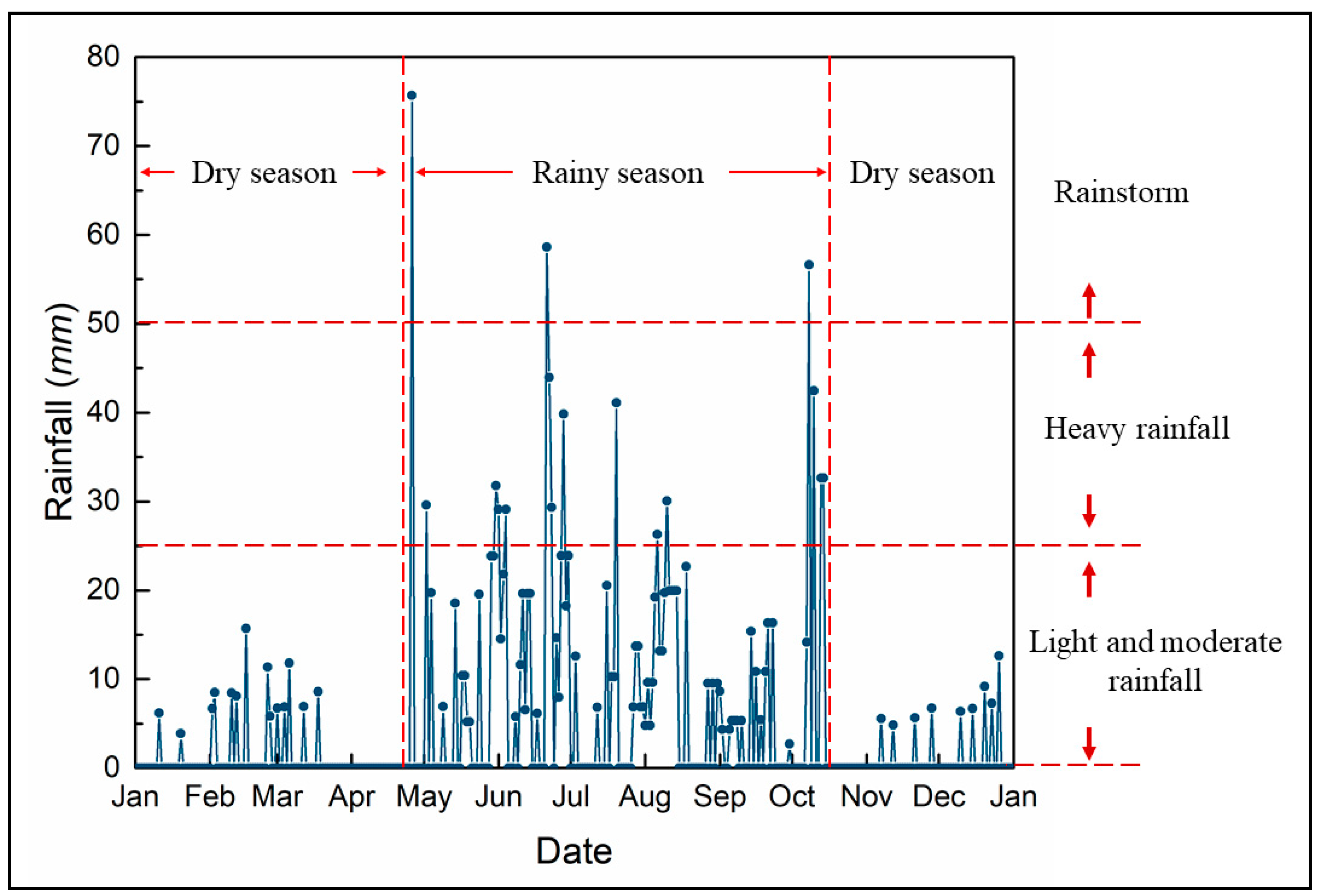
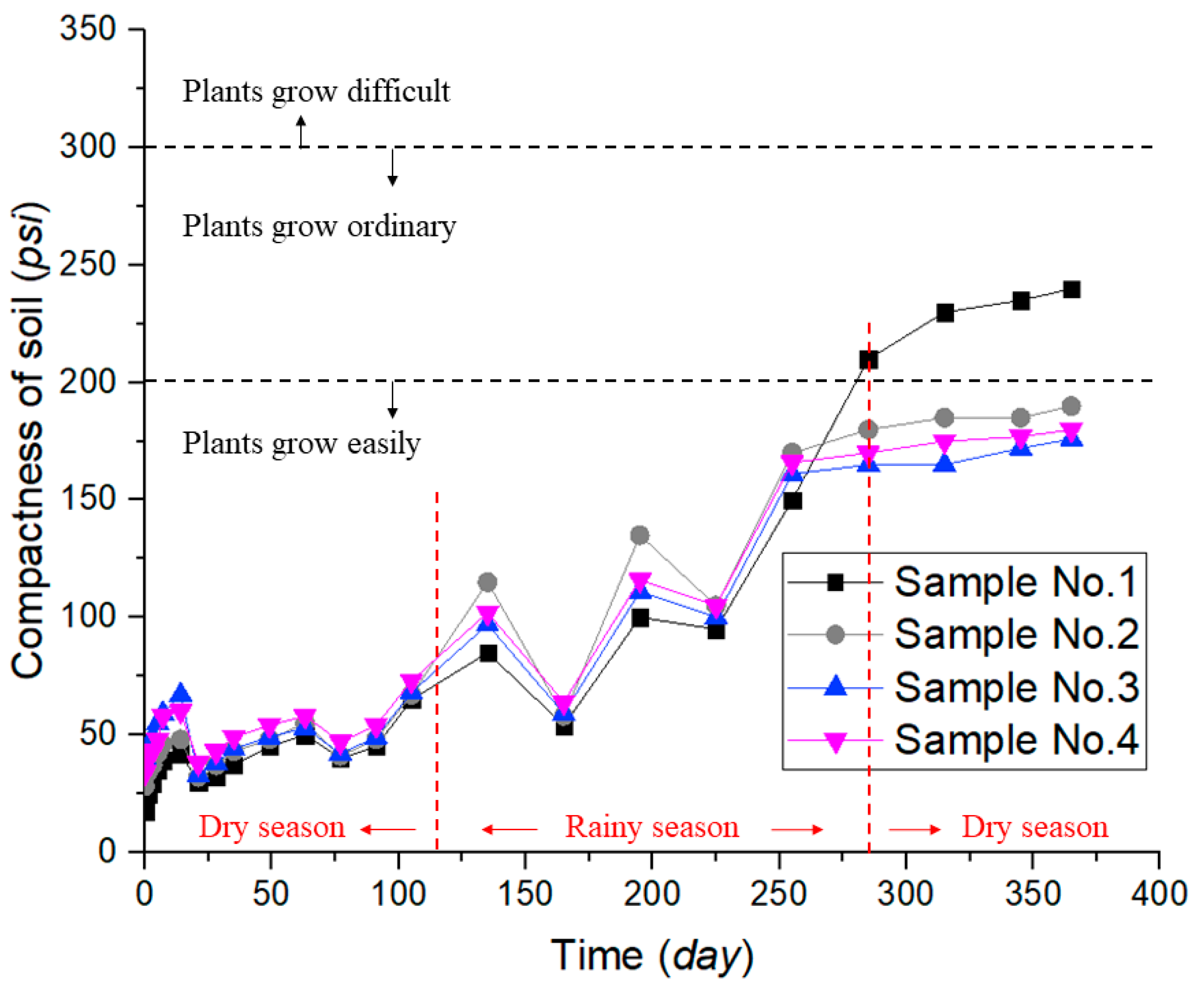
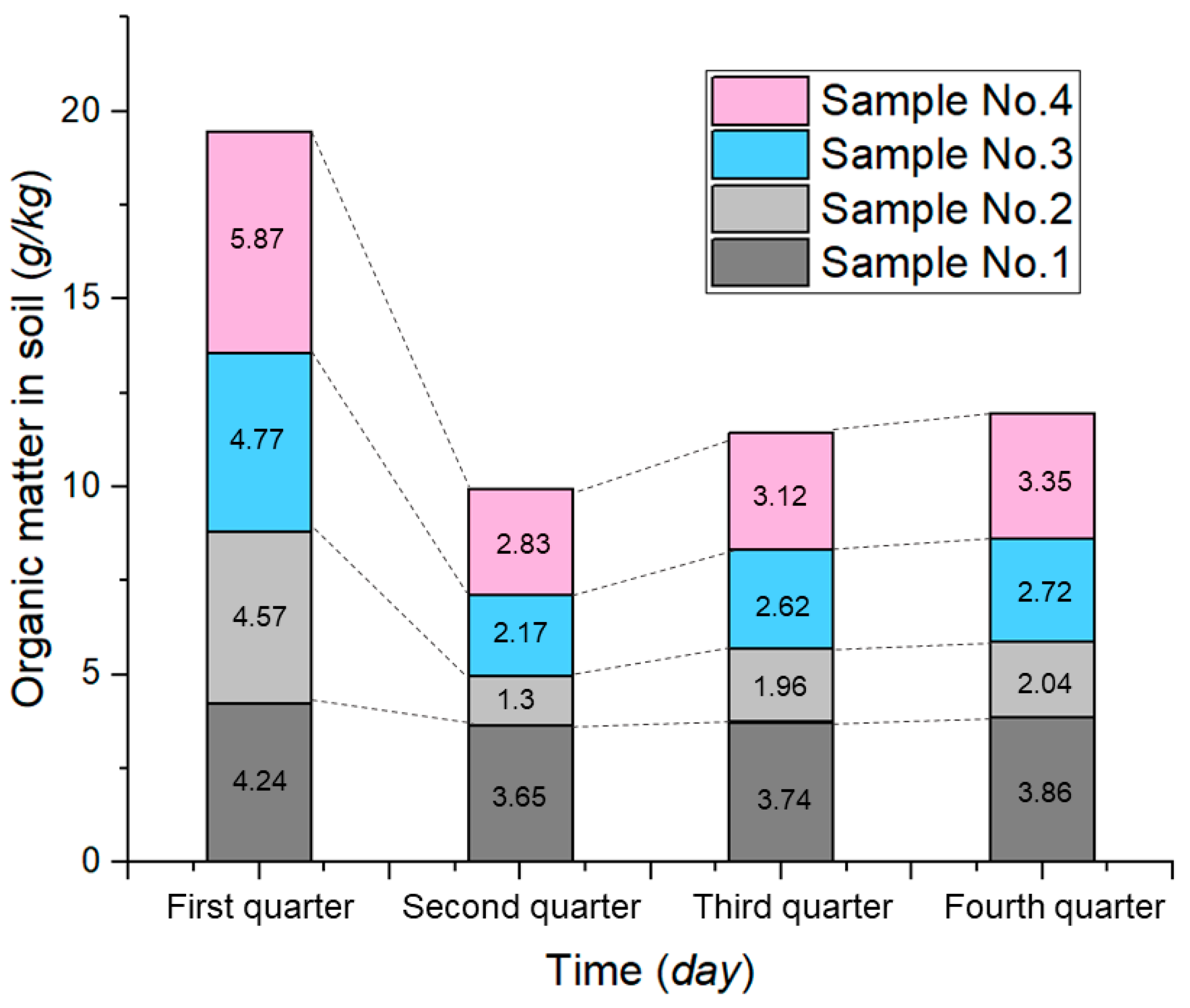

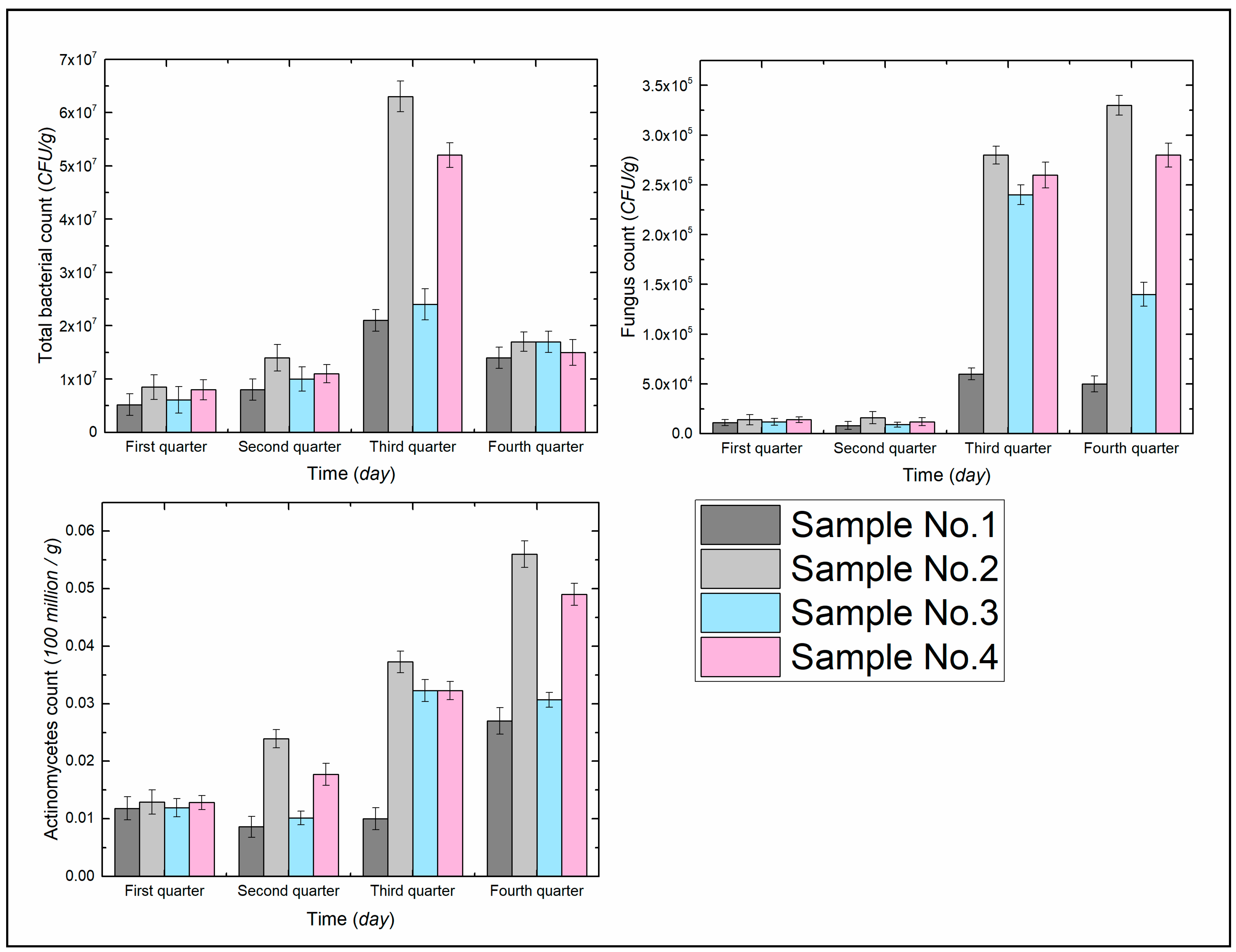
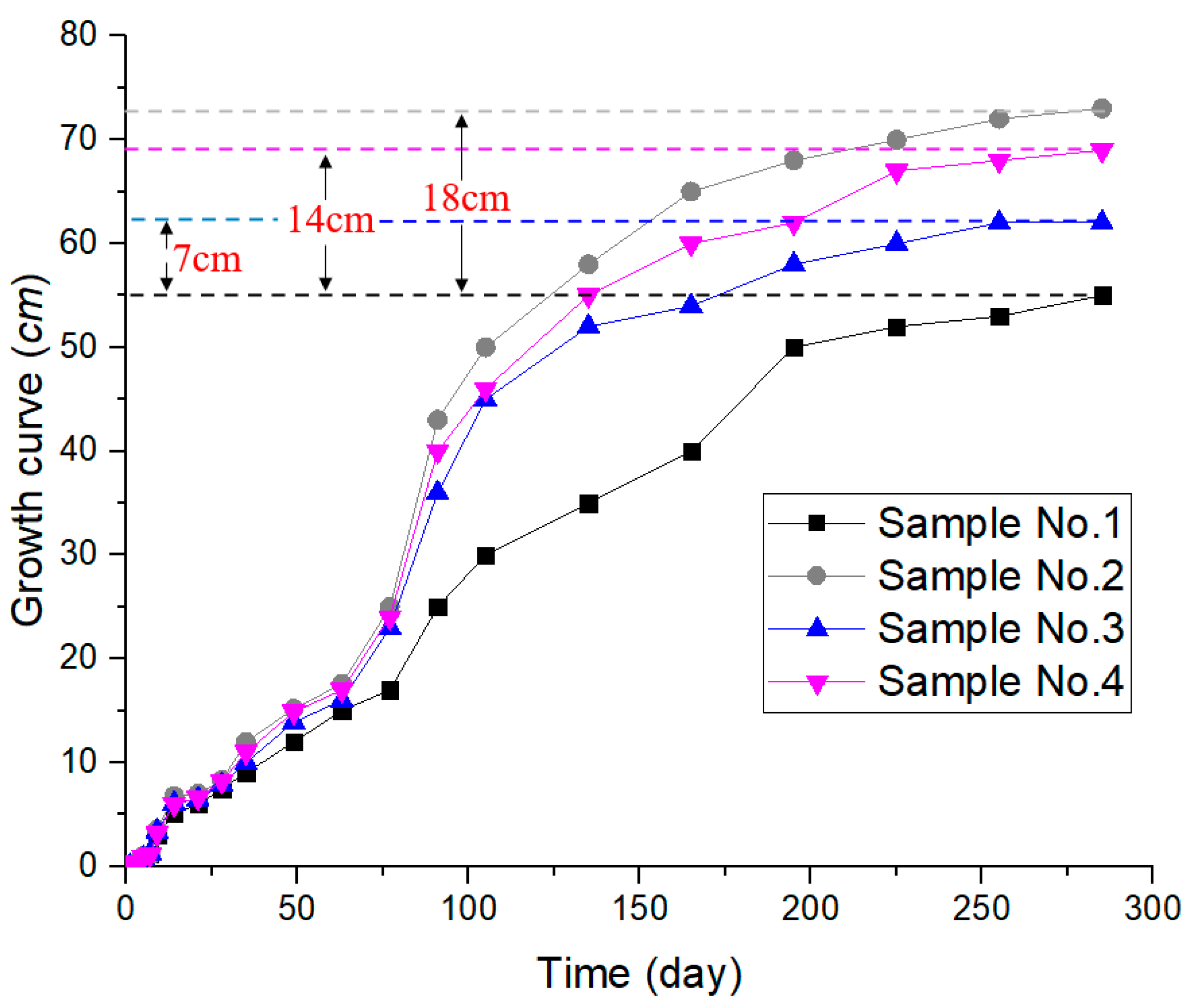

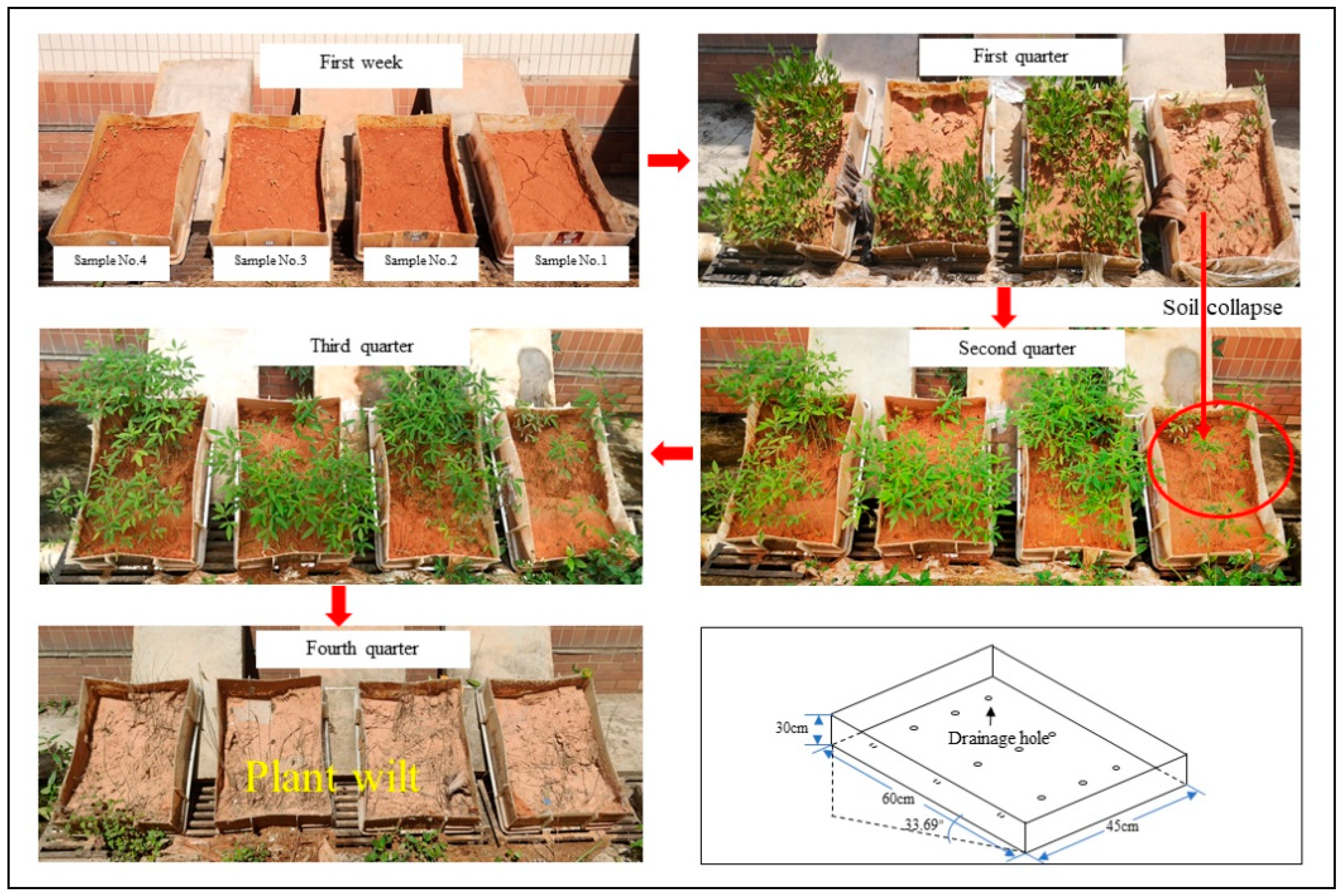
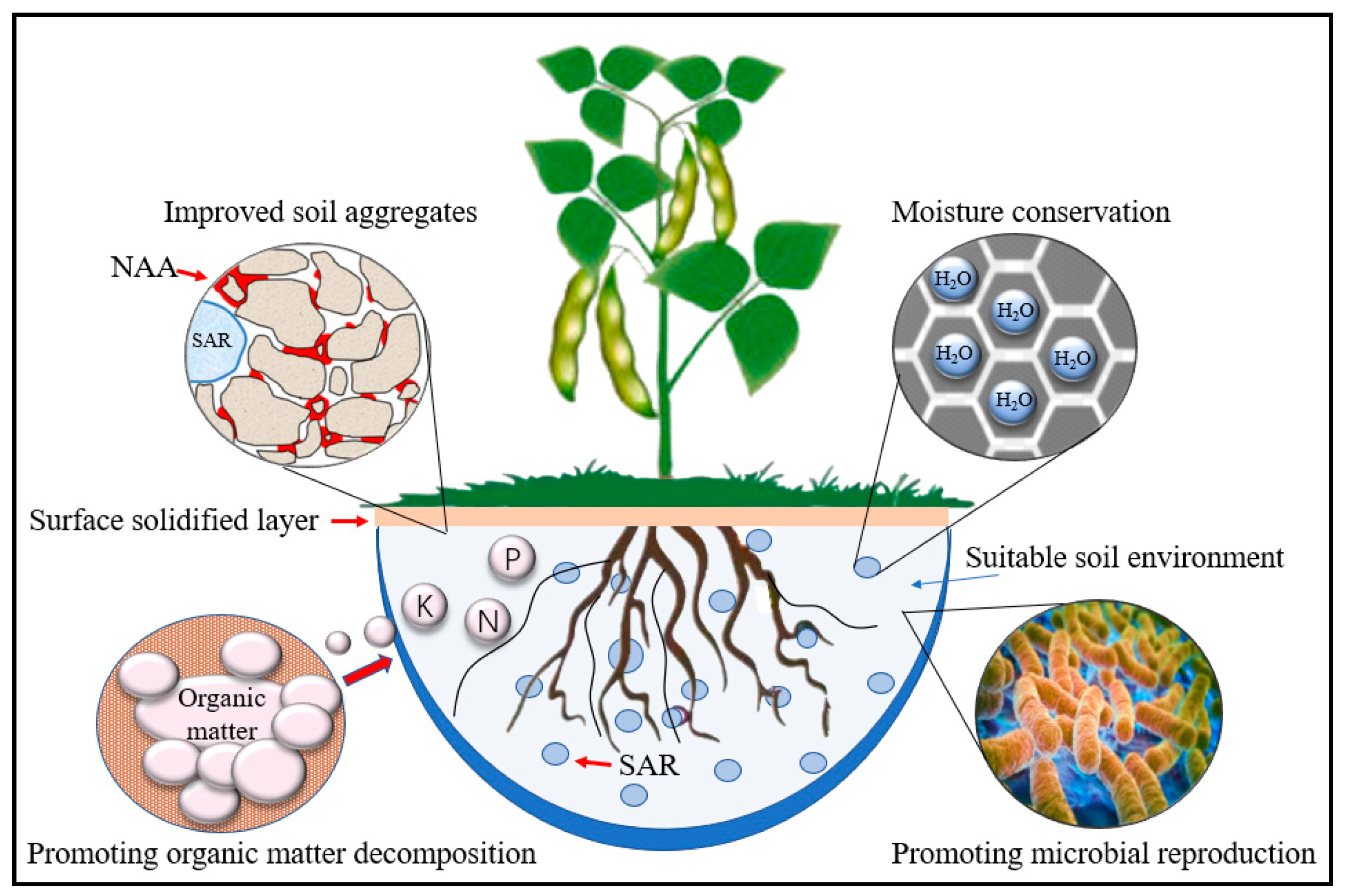
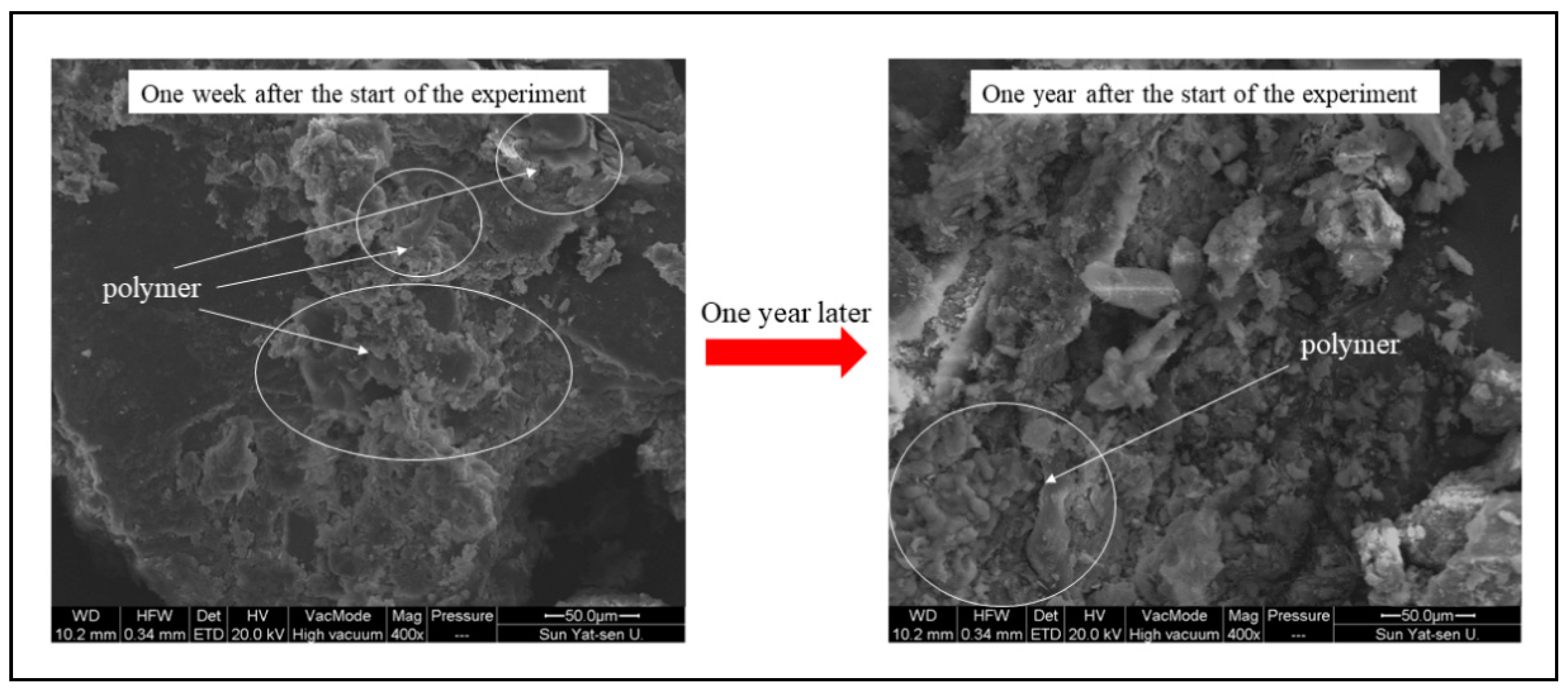
| Parameter of Natural State | Natural density ρo | 1.98 g/cm3 |
| Specific gravity Gs | 2.68 | |
| Water content ω | 19.7% | |
| Void ratio e | 0.62 | |
| Degree of saturation Sr | 85% | |
| Index of Consistency | Liquid limit ωL | 30.2% |
| Plasticity limit ωp | 18.2% | |
| Liquidity inde IL | 0.13 | |
| Plasticity inde Ip | 12.0 | |
| Index of Consolidation | Compressibility αV | 0.338 MPa−1 |
| Compression modulus Es | 4.79 MPa | |
| Mechanical Parameters | Cohesion C | 34 kPa |
| Internal friction angle φ | 25.9° |
| Material Type | No. 1 (CK) | No. 2 | No. 3 | No. 4 |
|---|---|---|---|---|
| NAB (g/m2) | 0 | 10 | 10 | 15 |
| SAR (g/m2) | 0 | 60 | 70 | 70 |
| Type | No. 1 | No. 2 | No. 3 | No. 4 |
|---|---|---|---|---|
| Total nitrogen (%) | 0.029 | 0.031 | 0.030 | 0.031 |
| Total phosphorus (%) | 0.037 | 0.037 | 0.037 | 0.036 |
| Total potassium (%) | 2.54 | 2.59 | 2.54 | 2.57 |
| Type | Germination Time (Day) | Germination Rate (%) |
|---|---|---|
| No. 1 | 5 | 15 |
| No. 2 | 3 | 55 |
| No. 3 | 35 | |
| No. 4 | 49 |
Publisher’s Note: MDPI stays neutral with regard to jurisdictional claims in published maps and institutional affiliations. |
© 2022 by the authors. Licensee MDPI, Basel, Switzerland. This article is an open access article distributed under the terms and conditions of the Creative Commons Attribution (CC BY) license (https://creativecommons.org/licenses/by/4.0/).
Share and Cite
Huang, W.; Zhou, C.; Liu, Z. Model Test Study on the Enhancement of Ecological Self-Repairing Ability of Surface Slope Soil by New Polymer Composites. Int. J. Environ. Res. Public Health 2022, 19, 9933. https://doi.org/10.3390/ijerph19169933
Huang W, Zhou C, Liu Z. Model Test Study on the Enhancement of Ecological Self-Repairing Ability of Surface Slope Soil by New Polymer Composites. International Journal of Environmental Research and Public Health. 2022; 19(16):9933. https://doi.org/10.3390/ijerph19169933
Chicago/Turabian StyleHuang, Wei, Cuiying Zhou, and Zhen Liu. 2022. "Model Test Study on the Enhancement of Ecological Self-Repairing Ability of Surface Slope Soil by New Polymer Composites" International Journal of Environmental Research and Public Health 19, no. 16: 9933. https://doi.org/10.3390/ijerph19169933






